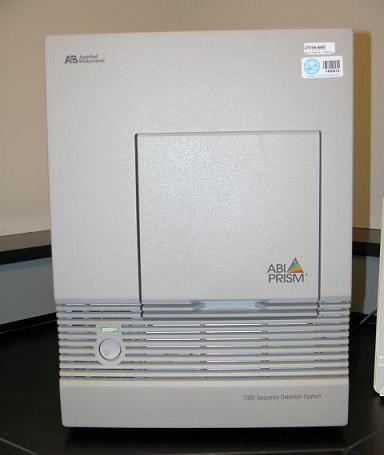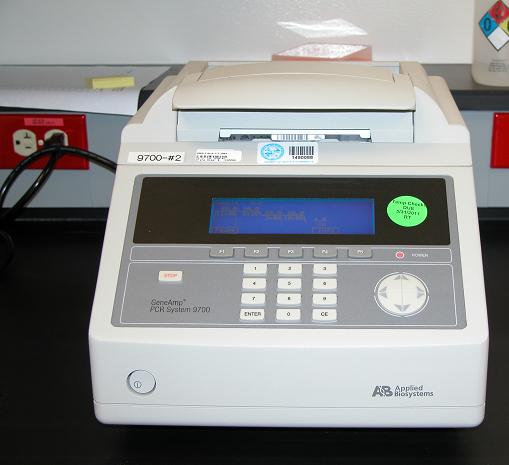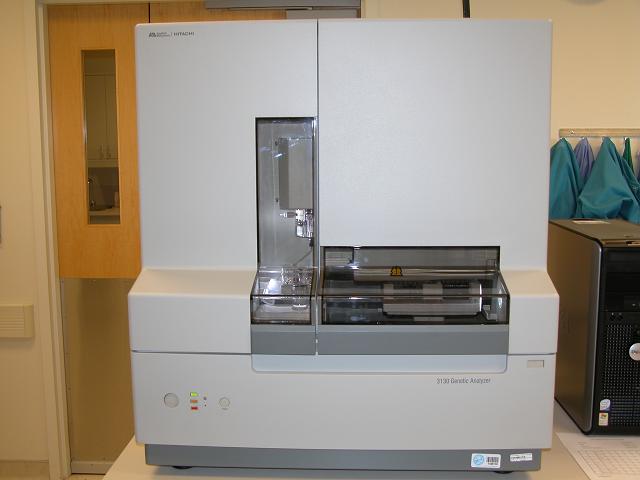The DNA testing process is comprised of four main steps, including extraction, quantitation, amplification, and capillary electrophoresis.
Extraction
DNA is located within the nucleus of cells throughout the body and the extraction step is responsible for breaking open the nucleus and releasing the DNA molecules into solution. During this step it is also possible to separate the DNA molecules from all other cellular material and any other debris that may be present in a particular biological sample. Some of these materials can be potential “inhibitors” to steps later on in the DNA testing procedure so it is important to try and isolate only the DNA molecules. Common inhibitors commonly found in forensic cases are hemoglobin and indigo dyes from denim. Two common methods of extraction used at the BCA are a manual Phenol-Chloroform (otherwise known as Organic Extraction) and through the use of a robotic system called the Maxwell® 16. Running samples on the Maxwell® 16 takes a minimum of two hours and samples extracted manually using the Phenol-Chloroform method takes a minimum of three hours.

Maxwell® 16 robotic instruments
Quantitation
One of the standards all DNA testing laboratories must meet is to ensure that the DNA recovered from an extraction is human rather than from another source such as bacteria. This is done through quantitation where the quality and quantity of DNA present in a sample is measured and assessed. Additionally, determining the amount of DNA in a sample is essential for success in the next step since most amplification systems require a narrow range of input DNA. This step is completed at the BCA through the use of a purchased Quantifiler DNA Human Quantification Kit and then running all samples on an instrument known as the ABI PRISM 7500 Sequence Detection System. This process takes approximately 30-60 minutes to set-up and then approximately two hours to run on the instrument.
Amplification
DNA amplification is accomplished through the use of a technique known as Polymerase Chain Reaction (PCR). PCR is a process in which millions of copies of a specific sequence of DNA can be made in a matter of only a few hours. This is important for forensic DNA samples since the DNA often found at crime scenes is limited in both quantity and quality. This molecular “xeroxing” process is completed by precise heating and cooling of the samples in a thermal cycling pattern for approximately 28 cycles.

The amplification kit used by the BCA amplifies 15 different regions of DNA as well as a sex-determining marker. The BCA uses a purchased AmpFlSTR Identifiler kit and then the samples are run on an instrument known as the GeneAmp PCR System 9700. This process takes approximately 15-30 minutes to set-up and then approximately three hours to run on the thermalcycler instrument.
Capillary Electrophoresis (CE)
After the PCR reaction is completed it results in a large mixture of amplified DNA molecules which need to be separated in order to distinguish the various molecules from one another. This is accomplished through a process known as capillary electrophoresis. DNA molecules carry a negative charge and once an electric current is applied to the sample the molecules enter a very thin capillary filled with a gel-like polymer and migrate towards the positive anode at the other end of the capillary. The PCR products are then separated by size because the smaller DNA molecules will have an easier time migrating through the polymer than the larger DNA molecules. The data from this process is then collected on a computer attached to the CE instrument and then through the use of a software program a DNA profile is developed. The BCA uses an instrument called the ABI Prism® 3130 Genetic Analyzer which is capable of analyzing four samples at a time. Set-up for this step takes approximately 10 -15 minutes and each injection on the 3130 takes approximately 45 minutes.

3130 Genetic Analyzer

Inside a 3130 Genetic Analyzer- 4 capillaries on right side

